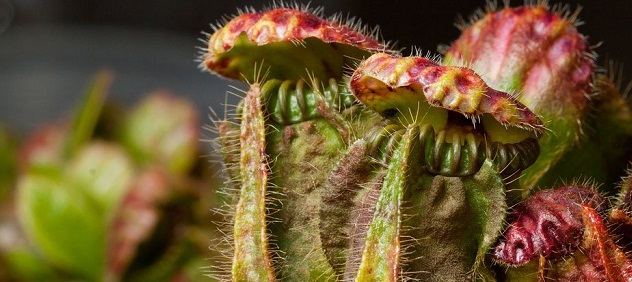"It suggests that there are only limited pathways for becoming a carnivorous plant," says biologist Victor A. Albert from the University at Buffalo.
"These plants have a genetic tool kit, and they`re trying to come up with an answer to the problem of how to become carnivorous. And in the end, they all come up with the same solution."
Albert and his team sequenced the genome of the Australian pitcher plant, Cephalotus follicularis, and compared it to existing genetic data for the North American (Sarracenia purpurea) and Asian (Nepenthes alata) species.
All these plants look similar, with a cupped, waxy leaf that`s slippery on the inside, so when insects venture in, they find it hard to climb back out again.
Once trapped, digestive fluids at the bottom of the chamber break down the prey, so the pitcher plant can absorb nutrients from its insect value meal.
The similarity between different kinds of pitcher plant has long been known to be an example of convergent evolution – in which distinct species independently develop the same traits.
But until now, scientists didn`t realise just how similar the biology was.
"Since Darwin, we`ve recognised convergence among pitcher plants in their form," botanist Thomas Givnish from the University of Wisconsin-Madison, who was not involved in the study, told The Christian Science Monitor.
"It`s convergence at a shallow level, where things look the same and they act the same. We [now] see it`s also convergence at a very deep level."
The distinctness of these three pitcher plants` lineages can`t be overstated. Cephalotus follicularis is more closely related to starfruit than other pitcher plants, while Sarracenia purpurea and Nepenthes alata share familial ties with kiwi fruit and buckwheat respectively.
But the analysis of the plants` digestive fluid shows that all three species pulled off the same trick over the course of their evolution: co-opting proteins that were originally used to defend against disease, and repurposing them into enzymes that could aid the digestion of insects unlucky enough to get trapped in the maw.
Two of these enzymes include basic chitinase – which breaks down insects` hard exoskeletons – and purple acid phosphatase, which lets pitcher plants absorb the nutrient phosphorus from their prey.
According to the researchers, the lineages of these different pitcher plants split more than 100 million years ago – long before they developed these carnivorous abilities.
So why did these species develop the taste for insect flesh, while other plants were happy to make do with sunshine and water?
The team thinks the answer lies in the environments in which these species grew, which could have been particularly poor in essential foods – failing to provide fertiliser-like elements such as phosphorus and nitrogen that help the pitchers grow.
"Carnivorous plants often live in nutrient-poor environments," explains researcher Kenji Fukushima in a press release, "so the ability to trap and digest animals can be indispensable given the dearth of other sources of nourishment."
The fact that all three species of pitcher plants chose the same evolutionary path doesn`t necessarily mean that other options weren`t open – but it could mean that repurposing defensive proteins towards digestive juices was the most practical survival route in the circumstances.
"Either there may be only a few ways of getting there, or only a few fast ways of getting there," Givnish told Chelsea Whyte at New Scientist.
/ScienceAlert/
More about:
















































